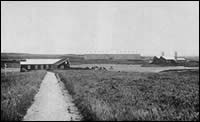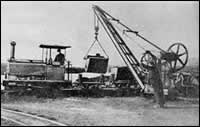 |
 |
 |
 |
 |
 |
 |
 |
 |
|




|
|
 
Wireless technologies, which we now consider as commonplace, have had an
enormous influence on our lives since their introduction by Marconi in 1896.
Ireland and the West of Ireland have played important roles in the development
and advancement of these new technologies. This ranged from the research
by Fitzgerald and others on the understanding of electromagnetic phenomena,
to Marconi himself and developments of the telecommunications companies
in Ireland. Ireland had several scientists who participated in no small
way to the development of electrical/electronic engineering as we know it
today. Some of the earlier contributors included Dr. Nicholas Callan from
Maynooth who developed the transformer shortly after the principle was discovered
by Faraday. In 1868, George Stoney proposed that light waves are produced
by periodic orbital motions within atoms and he was responsible for the
name electron. It was George Francis Fitzgerald, at Trinity College, in
the latter part of the nineteenth century, who made some of the most significant
contributions to the understanding of electromagnetic phenomena.
He was interested in the work of Clerk Maxwell who had made the initial
proposal of electromagnetic propagation in air. Based on his own work, and
the experiments of Heinrick Hertz in Germany, FitzGerald was able to offer
the proof for the Maxwell theory. This was certainly a very important step
along the road to the breakthrough of Marconi in 1895.
Another active researcher was Joseph Larmor, Professor of Physics at Queen's
College Galway from 1880 to 1885. He contributed to field theory and electrodynamics
and derived an expression to predict the radiation from an accelerating
electron. His successor, Professor Anderson, at Galway, had a keen interest
in the work of Marconi and had a Marconi set in the University by 1902.
|
|
| |
|
|

Guglielmo Marconi was
born in Bologna in 1874. His father was Italian and his mother was from
Co. Wexford, a member of the Jameson Irish whiskey family. As a boy in his
teens, he came in contact with Professor Righi of Bologna who was experimenting
with electromagnetic waves.
He set up his own laboratory at home to experiment with the transmission
of electromagnetic waves. Up to this point, all transmissions were indoors
and over very short distances. Using an elevated antenna from the spark
gap transmitter and an elevated receiving antenna, Marconi was able to receive
transmissions over a mile and a half in the summer of 1895.
This was an incredible advance and it was to earn Marconi the title of inventor
of wireless communication. Remember that he was still just 21 years of age
at the time of this discovery. Marconi moved to England and was granted
a patent for his invention.
With the help of his Jameson cousins, he was set up the Marconi company
in 1897. For the next forty years, Marconi was to make numerous contributions
to global communications. During the course of his career, he was to receive
many awards including the Nobel Prize for Physics with Braun in 1909.
|
|
|
 
The early transatlantic signals (1901-1905) were between Poldhu, Cornwall
and Glace Bay, Nova Scotia. In 1905 Marconi put in hand the plans for
the erection and equipping of the new high-power station at Clifden, with
a view to establishing a regular commercial service across the Atlantic.
Thus, the work
at the Clifden site was started in October 1905. A limited public service
was inaugurated on October 17th 1907 and this service was made available
to the general public on February 3rd 1908. This established the Clifden
station as the vital link in transatlantic wireless communication in the
early part of this century.
Really long wavelength radio waves were employed for these communications,
that of Clifden being over 6,000 metres and that of Glace Bay over 7,000
metres, the separation being sufficient for simultaneous transmission
in both directions, an innovation at that time.
Both transmitters were equipped with extensive multi-wire aerials covering
an area of, approximately, one quarter of a square mile, and supported
on twenty or twenty-five steel and wooden masts, each over two hundred
feet high. The station receiving the signals from Glace Bay was situated
up in the hills at Letterfrack, some twenty miles distant, and a single-wire
receiving aerial was stretched across the valley.
The Clifden facility was not small. The building in which the condenser
was housed measured 350 feet in length and 75 feet feet in breadth, and
the height of the eaves was 33 feet. The condenser itself consisted of
1,800 galvanised steel sheets, each measuring 30 feet by 12 feet, suspended
from the roof ties of the building by porcelain rod insulators.
The Clifden station continued to operate until the early 1920's when it
was destroyed during the Civil War.
|
|
|

By the second decade
of the 20th Century, Clifden was a key station in a wireless network that
circumnavigated the earth. The other stations were - Glace Bay, New Jersey,
Panama Canal Zone, Singapore, Bangalore, Aden (Yemen), Egypt and London.
This chain that circled the globe was but the main artery with feeders
and branch stations contributing to a more complete network.
It is interesting
to view some of the financial projections from 1912. The cost of a
submarine cable to cover a distance of 3,000 miles is anywhere from $7,000,000
to $10,000,000, while the total cost of a pair of wireless stations to
do the same work is but $600,000. The cable must handle $0.5m worth of
business in order to earn enough to keep it in repair while 2% of this
amount would take care of the same item for the wireless. Two million
words at 25 cents a word will earn only a sufficient sum to cover depreciation
of the cable, while the same number of words at half rate by wireless
will produce enough to pay depreciation charge and 35% on the investment
besides.
(by F. W. Sammis, The Marconigraph, 1912, p.255)
|
|

Unloading fuel for the station. |
|
| |

The West of Ireland tradition
in telecommunications continues to this day. Perhaps the best example of
this is the presence in Galway of Nortel Networks. The company also has
campuses in Dublin and Shannon. Nortel Networks a company that employs over
70,000 people in 150 countries, is a world leader in the development of
next generation telecommunications architecture, the next wave of Internet
technologies and pioneer e-business applications. The Nortel Facility in
Galway was established in 1973 and initially, it employed just 30 people.
It has expanded rapidly since then and evolved from a low tech, low volume
manufacturing plant to a campus style facility employing over 950 people.
It is responsible for customer service for the entire European, Middle Eastern
and African regions, as well as in the development and manufacturing of
highly sophisticated telecommunications equipment.
The Galway plant is home to one of Nortel Networks Global Systems Houses
and an internationally recognised Research and Development facility. Here
leading edge products such as Symposium Call Centre, Meridian, DECT Wireless
and INCA(Internet Communication Architecture) have been developed or are
currently under development. The global systems houses is a multi-dimensional
operations centre responsible for order engineering and testing of complex
customer voice and data solutions.
|
|
  |

